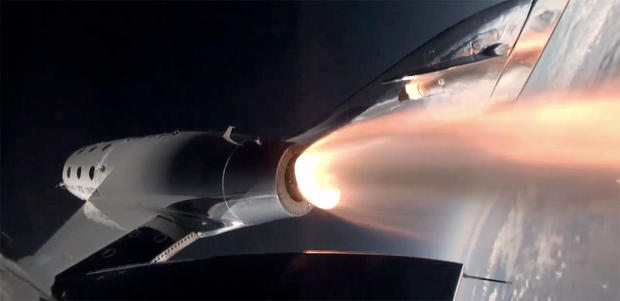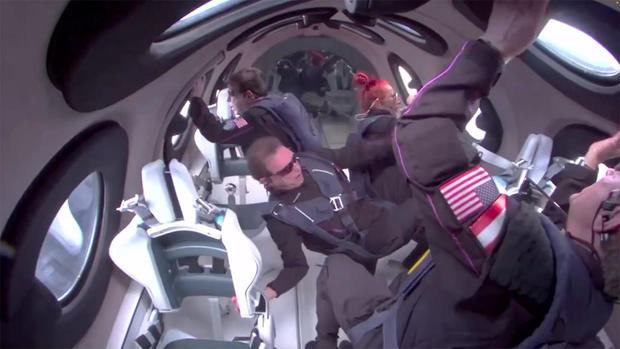Virgin Galactic launches 4 space tourists to the edge of space and back
Virgin Galactic's winged rocketplane carried a two-man crew and four passengers to the edge of space and back Friday, chalking up the company's 11th sub-orbital spaceflight and its sixth commercial mission.
With veteran pilots C.J. Sturckow and Nicola Pecile at the controls, the Unity spacecraft was carried aloft from New Mexico's Spaceport America by Virgin Galactic's twin-fuselage ferry ship Eve, taking off at 12 p.m. EST.
After climbing to an altitude of 44,493 feet, the carrier jet released the spaceplane and, a moment later, the pilots ignited Unity's hybrid rocket motor to kick off a supersonic near-vertical climb out of the lower atmosphere.

It was Virgin's first flight without a company astronaut chaperone on board, and all four seats in Unity's cabin were occupied by paying customers: Robie Vaughn and Neil Kornswiet, both American citizens, Franz Haider of Austria, and Lina Borozdina, who holds joint U.S.-Ukrainian citizenship.
Unity's rocket motor fired for about two minutes, boosting the ship's velocity to nearly three times the speed of sound before shutting down. At that point, the pilots and their passengers were weightless.
The spaceplane continued skyward on a ballistic trajectory, reaching a maximum altitude, or apogee, of 55.2 miles. That's five miles above the altitude recognized by NASA, the Pentagon and the Federal Aviation Administration as the "boundary" between the discernible atmosphere and space.

During about three minutes of weightlessness, as Unity arced over the top of its trajectory, the passengers were able to unstrap, float about the cabin and take in spectacular views of Earth far below, before returning to their seats for the plunge back into the lower atmosphere.
Virgin's spacecraft features unique hinged wings that rotate upward after engine shutdown to slow and stabilize the craft for re-entry. Once back in the lower atmosphere, the wings rotated back into their normal configuration and the pilots guided the ship to touchdown on Spaceport America's 15,000-foot-long runway 56 minutes after takeoff.
Virgin Galactic has now launched 55 passengers and crew on 11 sub-orbital space flights since an initial test flight in December 2018. The passenger list includes company founder Richard Branson.
Blue Origin, owned by Amazon-founder Jeff Bezos, also offers sub-orbital spaceflights using a more traditional rocket and crew capsule. The fully automated spacecraft can carry six passengers at a time. Blue Origin has launched 32 space tourists to date, including Bezos, along with multiple unpiloted cargo missions.
- In:
- Spacewalk
- International Space Station
- Virgin Galactic
- Space
- NASA
Bill Harwood has been covering the U.S. space program full-time since 1984, first as Cape Canaveral bureau chief for United Press International and now as a consultant for CBS News.
TwitterDisclaimer: The copyright of this article belongs to the original author. Reposting this article is solely for the purpose of information dissemination and does not constitute any investment advice. If there is any infringement, please contact us immediately. We will make corrections or deletions as necessary. Thank you.






